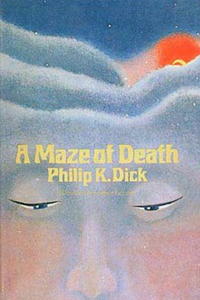I really liked “A Maze of Death” (written in 1968, published in 1970) on my first read. I enjoyed it when religions were made fun of, so I found it amusing that Philip K. Dick invents a reality wherein prayer is demonstrably real. Prayers give measurable results, and those doing the praying devise distinct strategies of how to pray and which gods to pray to.
On this reread, I found that aspect of the novel to be minor. My general impression is that “A Maze of Death” is a shadow of the 1982 group-paranoia movie “The Thing,” albeit with a few neat Dickian ideas on top of that structure.
Return to subjective POVs
The story finds Seth Morley and a dozen other people sent by a Communist government to the otherwise empty ramshackle settlement of Delmark-O. Their requests for new jobs have been approved, but they aren’t told what those jobs will be. When they get to the settlement, the satellite-based tape player that would explain their duties breaks down mid-message. There’s a creepy vibe to this, but the mystery isn’t as rich as it could be.

“A Maze of Death” (1970)
Composition year: 1968
Author: Philip K. Dick
Genre: Science fiction
Setting: Delmark-O, future
As with “Eye in the Sky,” which also happens to feature a character whose personal world involves demonstrably effective prayer, “A Maze of Death” is about subjective POV. But it’s not as effective, and PKD seems to know this.
He uses an Author’s Foreword – a rare tactic for him – to tell us right off the bat that every character’s POV is subjective and not representative of the wider reality. (I’ve encountered one other time when he uses a foreword, when he does a snarky fake-out in “In Milton Lumky Territory,” suggesting that novel has a happy ending.)
People begin to be killed off on Delmark-O, and they begin to mistrust each other, something reminiscent of “The Thing” – both film versions of which come from “Who Goes There?,” a 1938 novel by John W. Campbell Jr. Agatha Christie’s novel “And Then There Were None” followed a year later — a murder mystery where people are picked off one by one at a remote location.
Another colony of mental patients
Fans of “Clans of the Alphane Moon” might appreciate that Dick explores a colony of mental patients again. As one of their theories, the characters suggest they are part of an experiment, and indeed they are: They are mental patients being tested by the government to see if they can live and work together to build a successful colony.
So technically, we’re seeing an up-close portrayal of mental patients all along, and we’re seeing their early days as a colony whereas “Clans” finds them already established.
Before the cast gets whittled down, some of the characters are fun and evocative, including Susie Smart, who is sexually promiscuous in a way that’s a stereotype of golden-age SF and calls to mind Max in the “Dark Angel” episode “Heat.”

What’s unusual here is that PKD portrays Susie’s trait as an illness. Interestingly, this is arguably progressive for the times, although a modern reader might find it to be an attack on women’s sexual agency.
The group’s exploration of the area around the settlement is mildly engaging. There’s not much flora or fauna to see, but there is a building – called The Building – that moves around and has signs that read differently to different observers (one person’s Winery is another’s Witchery). That’s a fun segment, but it’s disappointing that the group can’t figure out how to enter The Building (which it turns out is their mental hospital).
More memory implants
I don’t usually expect a robust scientific explanation for things in a PKD book, but it strikes me as lazy here that these people simply had their memory of their status as mental patients erased and new memories implanted.
That’s a darn powerful ability the government has, something that goes well beyond the memory implants of the short story “We Can Remember It For You Wholesale,” the basis for the “Total Recall” movies and TV series. And the consequences of such a technology aren’t explored here; it’s more of a device of convenience.
Another thing that’s almost cool about “A Maze of Death” is the revelation that Delmark-O is actually Earth. The “It was Earth all along” trope is most famous from “Planet of the Apes,” of course, but PKD himself wrote a couple of short stories that pre-date that 1968 movie: 1952’s “The Gun” and 1953’s “The Impossible Planet.”
What makes those stories — and Isaac Asimov’s later “Foundation” books about the search for the lost Earth — so neat is the drama of the revelation about the state of the Earth.
Mysteries don’t pay off
But in “A Maze of Death,” we’re told prior to the big twist at the end that Earth is unpopulated and that “ostriches” – people who fear emigration to other star systems – live on platforms that orbit the planet. The novel might’ve had more drama if there was some surprise about the nature of Earth.
“A Maze of Death” doesn’t totally fail to absorb a reader. For a good chunk of the book, I found it to be an engaging page-turner as I wondered about the reason for this group of people being dumped at a seemingly pointless location.
The payoff turns out to be anti-climactic, and Dick could’ve had more fun with the functional prayers and made the mental patients much crazier. Still, as often is the case with PKD’s lesser works, the clever nature of the concepts have intrinsic appeal that propel and heighten the narrative perhaps more than it deserves.


thank you — a most interesting review
Thanks for reading, Tessa!